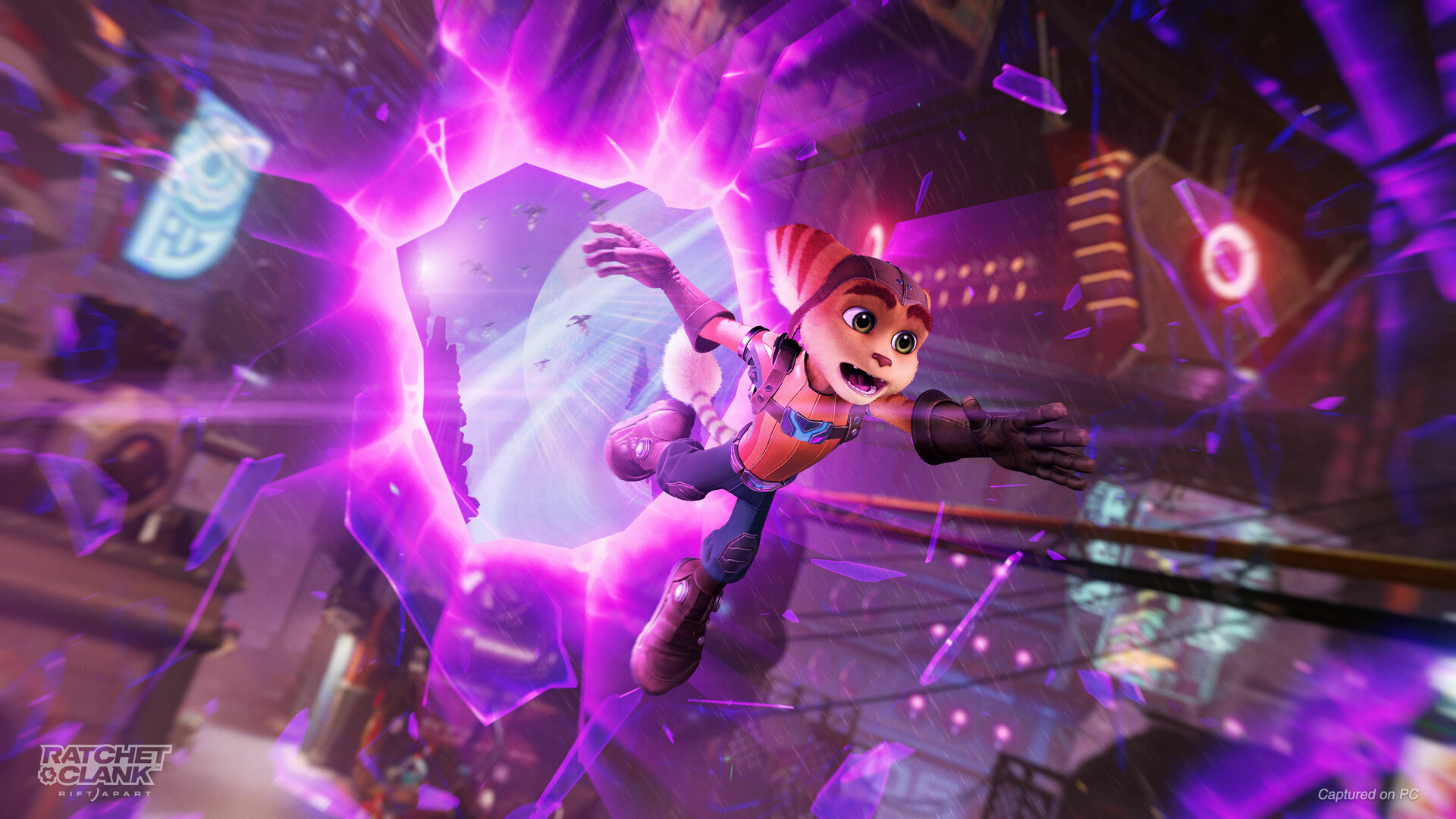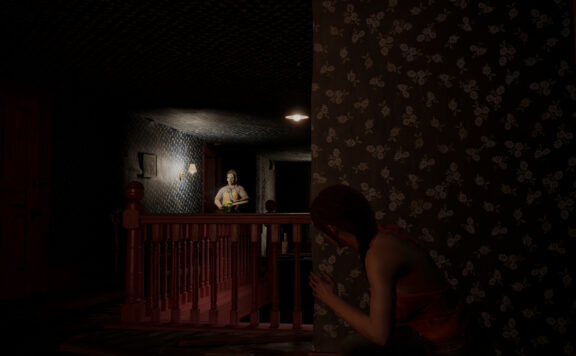Ratchet & Clank originally released on PlayStation 2 in faraway 2002. I tried my best to follow the series if only for the evolving story. When it comes to gameplay, the idea has not changed from those early games of the series and it is not necessarily a bad thing.
Of course the games of the series have progressed and gradually evolved since then: Insomniac introduced new technologies as well as used the creative experience the developers have gotten from working on other projects. But the essence has not changed in the last 19 years: more often than not, the protagonist will be crushing boxes, smashing enemies with a huge arsenal of weapons and more. Usually the more reasonable and level-headed of the two, Clank would be solving puzzles.
In 2021 Sony released their latest exclusive and the flagman title promoting the capabilities of PlayStation 5. Yes, the center of today’s attention is Ratchet & Clank: Rift Apart. Back in the day the company insisted that only the new-gen SSD of the PS5 was able to handle the game’s requirements and bring out its beauty.
Seeing how the PC version works on various machines and how much attention it has gotten from the wider community, I have decided to write this article on my thoughts about Sony and their approach to exclusive politics, management of the projects and more.
Ratchet & Clank: Rift Apart is an amazing game. It looks divine, is brilliantly optimized and overshadows many titles that came out between its initial launch and the release of the PC version.
Sony advertised the project as the beginning of the next-gen, and it is not just about the PS5 ultra-fast SSD which was “the only one” that could instantly load different worlds. It’s also about breathtaking delightful graphics, the number of effects, the crazy number of particles, the dynamics and a good story with a deeper message. The whole canvas of gameplay didn’t change much compared to the previous games in the series, and the lauded portals are implemented in a very simple way and don’t play as big of a role as expected. The PC controls are of a very high quality, I didn’t feel the need to change a single key in the control scheme. I enjoyed playing using mouse and keyboard and no-lifed the game over a weekend.
For those who have not bought PlayStation 5 and thus had no chance to play the game before, I strongly recommend that you give it a chance. Ratchet & Clank: Rift Apart is a bright and dynamic action with a wonderful change of scenery around your hero. Just don’t expect it to be the game of the decade. The plot tries to impress you with certain “Wow!”-moments but by and large they’re so predictable and expected that they just flash by due to the game’s dynamic pacing.
Let me remind you, recently released Remnant 2 shows an average performance even on the modern video cards. Only through enabling Nvidia DLSS or AMD FSR can you expect to see an acceptable picture while having to fight against the optimization even on a relatively new PC. So it was quite a surprise that Ratchet & Clank proved to be playable with a good ol’ 1060. I have tested the game on a number of GPUs: 1060, 1660, 2080 Ti and 3080. While I cannot say that 1660 handled the game too well, it was still pretty confidently pulling the medium settings, allowing you to enjoy the game.
One thing is for certain, Sony’s boasting that only the PS5 SSD can handle Ratchet was unfounded. In my case, the game was installed on an SSD WD Black. And the game really delivered on the promised instant downloads – and that’s when my curiosity was piqued. I tried installing the game on an Western Digital HDD and… saw 2-3 second loading from the same portals. Not a minute, not longer, but at most 4 seconds of loading screen where Ratchet flies from portal to portal.
Even SteamDeck handles Ratchet & Clank: Rift Apart on medium settings at 30 FPS and allows players to game without problems. This is Sony’s victory when it comes to optimization. And seeing a really beautiful and well-optimized game on the one hand, and the “built with DLSS in mind” non-excuses on the other, I am sincerely upset and puzzled at Sony’s policy regarding PC releases.

Because the embarrassing part is that its effects led to the game all but failing on the PC market when compared to its success on Sony’s own platform. A game with outstanding visuals and optimization quietly passed by the PC players when released on the platform. The peak concurrent online of the game on PC was 8700 people due to the time period between the console and the PC release as well as a complete lack of PR campaign. Zero advertisement, zero investment into recognition and promotion on the platform, that’s what Ratchet got.
Many PC players are simply not interested in other platforms. Recently, PCs got a number of loud new releases: Diablo IV, Jagged Alliance 3, Remnant 2, Baldur’s Gate 3. And these games have easily eclipsed Ratchet’s popularity for a variety of reasons, including being in front of everyone’s eyes.
Relatively recently Sony finally started releasing their exclusives on PC. The only question is “what for”. The first thing that comes to mind would be, why, to get more money, of course! But looking at HOW Sony brings these games to the platform, it doesn’t seem like the main motivator. Normally a studio bringing their games to a variety of platforms aims to sell the copies to the largest possible number of people. However, the re-releases of Sony exclusives didn’t get the popularity they could have received due to the lack of project promotion with a few rare exceptions.
Years after their initial release PC players were able to appreciate Sony exclusives: God of War, Spider-Man, Horizon and even The Last of Us Part 1, but the peak online of these games did not show any outstanding results, on the contrary, many were disastrously small. For comparison, Remnant 2 beat the peak online of many Sony titles. At the moment of writing, Remnant 2 had a peak online of 80 thousands while God of War “only” had 73 thousands.
Let me remind you: Remnant 2 was not published by one of the biggest companies out there. It is a sequel to a successful predecessor from a company that doesn’t have anything close to Sony’s budget. On the other hand we have God of War, one of the greatest PlayStation exclusives which sold millions of copies. Don’t these numbers seem strange to you?
Reading the comments on forums, some players don’t seem to realize that the game they picked up is a former Sony exclusive that made its way to PC over 2 long years after the original release. Just look at Sackboy, many players don’t realize its meaning or what is the idea behind the series overall. I have seen people ask questions about The Last of Us Part 1 that amounted to “Is the game based on the series?”

Seeing all of the above, you can’t help but wonder about such contradictions and inwardly ask questions into the void.
Starting with the price. Yes, we are talking about former exclusives with high-quality graphics and gameplay and usually without technical problems (but not always). But looking at the PlayStation store, the games there usually cost less and sometimes are even a part of the free games provided with the PlayStation+ subscription.
Secondly, Sony seems to want to promote their consoles through the PC releases. That is, the company releases their games on PC while simultaneously advertising their own platform, showing PC players that real exclusives release on PlayStation and usually a year or even a few in advance of PC. Why would you wait that long to play the God of War sequel? All you have to do is buy a PlayStation! But it also doesn’t seem to be working too well as the company does not really promote its products for PCs.
- The peak concurrent users for Sackboy: A Big Adventure is 600 people;
- Returnal – 6700 people;
- Uncharted, a wonderful game with a bombastic plot and gameplay and excellent acting – only 11000 people;
- Days Gone – 27000 people;
- The Last of Us Part I – 36000 people.
And the three most successful games of Sony on PC: God of War, Marvel’s Spider-Man and Horizon: Zero Dawn – 73 thousand, 66 thousand and 56 thousand players respectively. Looking at the numbers, it feels like only the sequels of the last three projects have a chance to leave a lasting impression.
Not to mention, some exclusives were quite disastrous upon the initial PC release. With The Last of Us Part I being released as the hype from the Netflix series was fading, it also was nigh unplayable for the first couple of months. Of course the developers have fixed it, but the initial impression matters.

Sony wants to popularize their console among PC users but without spending money on PR, marketing and promotions. But the current approach of the company does not seem to be working. Then again, with the numbers coming from sales on PlayStation consoles themselves, do they really need it to show splendid results?
Until the company revises the price policy or stops releasing games years after their initial launch, former PlayStation exclusives are unlikely to make a huge impact on the PC scene, let alone expand the PS audience.
PC gaming is an entirely different ecosystem. Just look at Xbox Game Pass, how many games can you get for the price of a subscription? What about the convenience of use? Phil Spencer came to the conclusion that there is no need to drag PC players over to consoles a long time ago. Want to play on PC? Go ahead. Prefer Xbox? Sure thing. Cross-platform for most products is in, older titles support exists. I still have the original The Witch and the Hundred Knight on my account but I can’t play it unless I buy the Revival Edition.
Microsoft games release on PC and consoles at the same time and it is an excellent policy in and of itself. For example, Forza Horizon 5 launched on PC and Xbox on the same day and continues to be a huge success on both.
With years between the original PlayStation release and the launch of the PC edition, interested players can easily watch the full walkthrough on Youtube without spending a cent on the game. Outside of hardcore fans or those who don’t really care either way, people are not going to wait for a single game for a few years. There are many other options to choose from, just look at the mad popularity and peak concurrent players for Baldur’s Gate 3.







